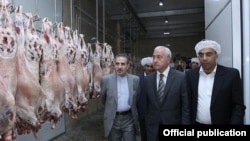An Armenian-Iranian joint venture has built Armenia’s largest slaughterhouse which is expected to significantly boost exports of halal meat to neighboring Iran, a key market for sheep raised in the South Caucasus country.
The company called Golden Axe inaugurated the abattoir located in Masis, a small town 20 kilometers south of Yerevan, on Wednesday at a ceremony attended by Agriculture Minister Sergo Karapetian and Iran’s ambassador to Armenia, Mohammad Reisi. It is said to have a capacity to slaughter up to 1,000 sheep and 200 cattle a day in accordance with Islamic norms.
Speaking at the ceremony, Karapetian said the launch of the 2,400-square-meter facility will result in a major increase in Armenian exports of lamb to Iran. That will in turn give a further boost to sheep breeding in Armenia, he said.
Reisi was also reported to predict a rise in those exports. A statement by the Armenian Agriculture Ministry quoted him as saying that there is strong demand in the Islamic Republic for halal meat from Armenia because of its high quality. More such Iranian-owned abattoirs could therefore be opened in the country in the near future, added Reisi.
Due to a lack of halal abattoirs, Armenian lamb has until now been exported to Iran and Gulf Arab states mainly in the form of live sheep. Those exports have risen dramatically since 2010. In 2013, for example, Armenia exported almost 118,000 sheep worth an estimated $15 million. According to government data, 85 percent of them were delivered to Iran.
Armenia’s overall sheep population reportedly stood at around 690,000 as of the beginning of 2014, up from 470,000 in 2010. Karapetian said that it can be tripled within years when he inaugurated a smaller halal slaughterhouse built by other Iranian entrepreneurs near Yerevan in late 2013.
“One should bear in mind that Armenia has more than one million hectares of mountain pastures, only 25 percent of which are being used at present,” the minister said at the time.
Iranian livestock breeders backed by the government in Tehran attempted to lease some of those pastures in the southeastern Syunik province earlier in 2013. The proposed deal was backed by the provincial administration but subsequently blocked by the Armenian government amid an uproar from environment protection and opposition groups in Yerevan.
The latter warned of its negative ecological, economic and even political consequences for Armenia. Some critics said the very fact of Armenian territory being rented out to a foreign state is unacceptable.
According to the National Statistical Service (NSS), Armenian exports of livestock, meat, sausage and related foodstuffs totaled $50.6 million last year. They accounted for 3.3 percent the country’s overall export revenue.





